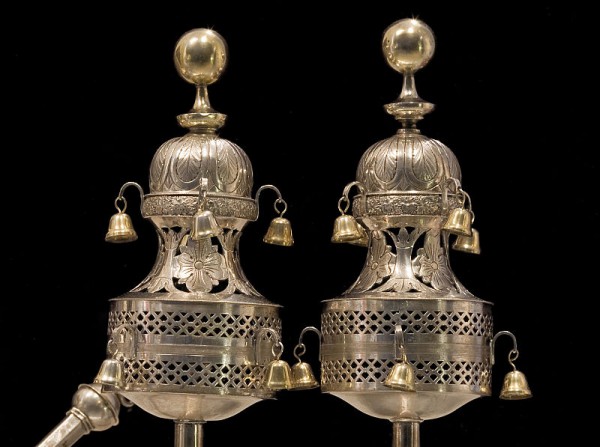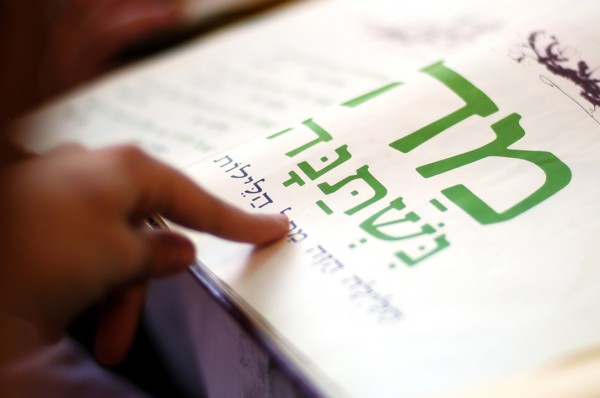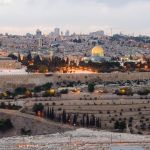“For the law will go forth from Zion and the word of the LORD from Jerusalem.” (Isaiah 2:3)
The Torah is the first WORD OF GOD, that was given to Israel and then to the world through Moses, 3,500 years ago.
Then, Yeshua (Jesus) came as the Word of God in Flesh. (John 1:1)
We can read about His life in the Brit Chadashah (New Testament).
But are you curious to know how the Jewish People have preserved the Written Word of God in the Tanakh (Old Testament), even from the time that Moses first received the Law on Mount Sinai?
We will discover the strict rules for copying and creating a Torah scroll, from the skin of the scroll itself to the ornate decorations of its ark and, of couse, the honored scribe.
In 2013, the world’s oldest complete Hebrew Torah scroll, called a Sefer Torah (Book of Torah) in Hebrew, was discovered by Mauro Perani, a professor of Hebrew studies at Italy’s University of Bologna.
The scroll is a real treasure because it may be as much as 900 years old, according to Carbon-14 dating results.
“We don’t have anything much from that period,” said acting president of the University of the Holy Land in Jerusalem Stephen Phann, who is an expert in ancient Jewish manuscripts. (Times of Israel)
While fragments of the now famous Dead Sea Scrolls are much older, they are only fragments and do not represent a complete scroll of the first five books of the Hebrew Bible—Genesis, Exodus, Leviticus, Numbers, and Deuteronomy—which together are the Torah (literally, instruction).
What’s more, since the Nazis and Italian fascists destroyed so many Torah scrolls during the Holocaust, the discovery of this scroll in an Italian university library is more than astonishing. (JPost)
Even though this particular scroll may be 900-years-old, there are Torah texts that predate it by more than 200 years: the Leningrad Codex, for example, is a complete handwritten Hebrew Bible manuscript bound in book form that dates to AD 1008.
The Leningrad codex was likely copied from the Aleppo Codex, which is a slightly older manuscript. When it comes to the Tanakh (the entire Hebrew Bible), the Aleppo Codex is considered the authoritative Torah text; however, parts of it have been missing since 1947.
Both the Leningrad Codex and Aleppo Codex have been used to create modern versions of the Tanakh. They will also be the foundation, along with the Dead Sea Scrolls, for the critically important Messianic Prophecy Bible.
“All Your words are true; all Your righteous laws are eternal.” (Psalm 119:160)
The Torah Scroll: A Painstaking Labor of Love
“The law of the LORD is perfect, refreshing the soul. The statutes of the LORD are trustworthy, making wise the simple.” (Psalm 19:7)
Traditionally, Torah scrolls, like this one discovered in Italy, are very different from the everyday, mass-produced bound book.
They are still painstakingly handwritten according to exacting standards of production by a sofer (scribe).
The scribes who write the scrolls are traditionally Orthodox men, although there is no clear Biblical mandate restricting women from this task. Nevertheless, according to Rabbinic writings in the Talmud (Gittin 45b), a scroll scribed by a woman or a minor cannot be placed into ritual use.
That has not stopped modern women from entering this ancient vocation. Women scribes completed a Torah scroll in 2010 in Seattle, Washington through the Women’s Torah Project initiative, led by Wendy Graff.

A sofer (scribe) can transcribe the Torah, tefillin (phylacteries), mezuzot (attached to the doorpost of Jewish homes, the books of the prophets (i.e. Isaiah), other scrolls such as Song of Songs and the Book of Esther, and gittin (divorce documents).
To become a scribe requires rigorous study, training, and great skill, although the character of the individual is also of importance.
To become a scribe requires rigorous study, training, and great skill, although the character of the individual is also of importance.
A scribe must be a God-fearing, pious person, who is dedicated to the sanctity of the Torah scroll. (Chabad)
“Your commands are always with me and make me wiser than my enemies.” (Psalm 119:98)
Hundreds of laws govern even the minutist details of creating a Torah scroll, the text of which is written on 62 to 84 sheets of parchment.
The parchment is made of the prepared hide of an animal such as cattle, goat or deer. The hide is either gevil (unsplit hide), which is preferred, or k’laf (two halves of the split hide).
The laws even govern which animals are used for the hides and which materials are used for writing and sewing.
“The k‘laf/parchment on which the Torah scroll is written, the hair or sinew with which the panels of parchment are sewn together, and the quill pen with which the text is written all must come from ritually clean—that is, kosher—animals,” George Robinson explains in his book, Essential Torah.
To ensure that the final product conforms to strict standards of production, the scrolls are thoroughly inspected by scribes who are specially trained in the religious laws governing the proper writing and assembling of a scroll.
Today, the text of a new scroll can be proofed by scanning it into a computer, which compares it to a standard text.
Before the individual sheets of parchment are permanently sewn together, a scribe is required to correct any inconsistencies revealed during inspection, such as letters that are missing or touching, incorrect spacing or other human error.
If any one letter is missing, cracked, or even smudged, the entire Torah is not kosher, but such problems can be corrected by scraping off the mistake after the ink is dried. Of course, the parchment must be prepared once again in that spot to accept the ink.
If a mistake has occurred in writing the name of God, however, the entire sheet of parchment becomes invalid and the text on it must be rewritten on a new sheet.
Once the scroll has been thoroughly checked for errors, it can then be attached to wooden rollers called the Etz Chayim. Nothing containing iron or steel may be used because those materials are associated with instruments of war.
Writing the Torah
“You gave them regulations and laws that are just and right, and decrees and commands that are good.” (Nehemiah 9:13)
Prior to doing the work, the scribe cleanses in a mikvah (ritual bath). After that, a special prayer for writing the scroll is recited.
The quill and ink are then checked by writing the word “Amalek” on a piece of parchment and crossing it out, literally fulfilling the commandment in Deuteronomy 25:17-19 to blot out the name of Amalek, Israel’s ancient mortal enemy.
The parchment is prepared by the scribe by scratching 43 horizontal lines in it and one vertical line at each end. This allows for the standard 42 lines of writing. Each parchment has two to three columns of text.
To write the characters of the Torah on the animal hide, a quill is dipped in a special black ink made of powdered gall nuts, copper sulfate crystals, gum arabic, and water. For the sake of freshness, it is prepared in small batches. (betemunah)
If the quill is made from an animal, that animal must be kosher. While the quill is usually made from a turkey or goose feather, a reed pen can also be used.
The exactly 304,805 letters comprising the Five Books of Moses of the Torah must conform to strict standards of size, lettering style, and layout. The letters appear as Hebrew block letters but special letters are enhanced with crowns or tagin.
A special style of writing called the “Assyrian” script is employed. Although in the past different styles were used by different groups, such as the Ashkenazi Jews (European) and the Sephardic Jews (Oriental), today there is greater conformity.
All writing must meet exact specifications set down between the 7th and 10th centuries in Tiberias by the Masoretes—scribes and Torah scholars who compiled the pronunciation and grammatical system used by the Jewish community today—or the Torah is not kosher.
Certain passages also have a unique form to emphasize a particular theme.
One example of a specially formatted passage is the “Song of Moses” found in Exodus 15:1–19, which was sung by Moses and the Israelites after they had safely crossed the Red Sea. In that Torah passage there are three interlocking columns symbolizing the parting of the sea and the Hebrew children passing over on dry ground.

The Song of the Sea, also called the Song of Moses, is included in Jewish liturgy and is recited in the daily Shacharit services.
Torah Construction and Quality
Torah scrolls can take from nine months to a year to produce. The Ashkenazi Torah takes longer to write and is therefore, more expensive than the Sephardi Torah.
The time difference is due to how difficult or easy it is to write the three Hebrew scripts used today: Beit Yoseph, Ari, and Vellish. Vellish, which is generally used by the Sephardic community, is more rounded and quicker to write. (Soferstam)
Because Torah scrolls differ widely in quality, they vary in price from $20,000 to $50,000, depending on the sofer’s (scribe) experience and skill.
For instance, although penmanship standards must be met for a scroll to be acceptable, some scribes are renowned for their superior handwriting style.
Other factors to consider in the cost include the materials used and the thickness of the parchment. Even the process of tanning the leather parchment can influence the price.

A Jewish father and son carry the Sefer Torah at the Western (Wailing) Wall in Jerusalem. The black straps that are connected to the boxes on their forehead are called tefillin.
No Ordinary Book
“Love the LORD your God and keep His requirements, His decrees, His laws and His commands always.” (Deuteronomy 11:1)
The Sefer Torah is no mere book: it is holy to the Jewish People and to Believers in Yeshua, whom the Torah points to.
While the Torah is available for regular reading and studying in printed book form as the Chumash (five parts), the Sefer Torah is used for synagogue Torah readings.
Traditionally, it is read during Shacharit (morning prayer service) on Monday, Thursday, and Shabbat (Saturday).
The Sefer Torah is also read on Jewish holy days, including the evening of Simchat Torah (Joy of Torah), when the annual cycle of Torah readings are completed and a new cycle begins.
Adorning the Torah Scroll
“Your statutes, LORD, stand firm; holiness adorns your house for endless days.” (Psalm 93:5)
When it is not in use, the Sefer Torah is stored in the Aron Kodesh or Holy Ark, usually a cabinet adorned with an ornate Parokhet.
This curtain represents the partition between the Holy of Holies—where the Ark of the Covenant was placed in the Tabernacle and the Temple—and the Holy Place. (Exodus 26:31–33)
Today, the Aron Kodesh frequently is placed at the head of the synagogue and is often built into the wall that faces Jerusalem, the direction Jews face when praying.

The Parokhet (embroidered curtain) can be either inside or outside the Aron Kodesh (Holy Ark). Some of these cabinets are built around a theft and fireproof safe.
The Ark is considered the holiest spot in the synagogue, and since it contains the Torah scroll, the holiest object, the Parokhet is not the only adornment found there.
Inside the Ark, the Torah scroll is secured by the gartel, a sash used to tie the scroll together. The scroll is also covered by a Torah mantle, an ornate jacket typically made of elaborately embroidered velvet or even woven silver. Sterling silver and carved wood Torah cases are also common.
When Torah mantles are handcrafted, they run upwards of $400. Wood inlay and silver cases cost thousands of dollars.
To further honor the holiness of God’s Word, Torah scrolls are also often adorned with a sterling silver breastplate (tas), representing the breastplate worn by the High Priest during Temple times, and a crown (keter), representing the kingly nature of the Torah and the crown of the priesthood. (Collections Canada)
Elaborate silver finials called rimonim (literally, pomegranites) cover the wooden Torah rollers called Etz Chayim.
These items are often skilfully embossed with Jewish and Temple motifs such as pomegranates, tablets of the law, the tree of life, lions, the Star of David, etc.

Silver Rimonim: the bells on these rimonim, which cover the Etz Chayim, are reminiscent of the bells that adorned the hem of the High Priest’s robe. (Exodus 28:34, 36)
The Masoretic Text and the Torah
The text that appears in the Torah scrolls is called the Masoretic Text (MT).
The MT is considered the authoritative Hebrew text of the Hebrew Bible and defines the Jewish canon.
It also designates the exact letter-text of these books, including the Masorah or textual details that indicate vocalization and accentuation.

Although both ancient and modern Hebrew do not use vowels, the Masoretes developed a system of vowel markings under, to the left of and above the Hebrew consonants.
The Hebrew word Masorah refers to diacritic markings (vowel sounds, etc) of the Hebrew text and to the marginal notes that clarify spelling differences.
The Leningrad Codex, the oldest complete Hebrew manuscript of the Tanakh (Old Testament), uses the Masoretic Text.
Study of the Dead Sea Scrolls has shown the MT to be nearly identical with some texts of the Tanakh (complete Hebrew Bible) dating from 200 BC.
Prior to the work of the Masoretes, however, the Bible likely existed in some similar form as early as the first century.
Noted figures such as famed archaeologist W. F. Albright would place this date back as far as between c. 150 and c. 50 BC. (BibleResearcher)
The Hebrew consonants differ little from the text that was known to have been generally accepted as early as the 2nd century, or even the older Dead Sea Scrolls.
When comparison is made with the Ashkenazi Torah text used today, only nine scribal differences exist and these include such things as spacings and the usage of the Hebrew letters vav or yod.
For example, in Genesis (Beresheet) 4:13, Cain says, “My punishment is more than I can bear.”
The Hebrew word for bear, minso, has the letter vav in the Ashkenazi text while the Masoretic text does not.

Due to the extreme age and condition of this Yemenite Torah, which was written on parchment made from gazelle, it is no longer considered “kosher” or valid.
When comparing the Yemenite text of the Torah with the MT, there are three differences.
They exist in the same word in Genesis 41:45, “Pharaoh gave Joseph the name Zaphenath-Paneah and gave him Asenath daughter of Potiphera, priest of On, to be his wife.”
In the MT, Potiphera has three spaces that do not appear in the Yemenite text.
In all other respects the MT and Yemenite texts are identical, according to Shelomo at Mechon-Mamre.
Some differences exist between the MT and the Greek manuscript of the Bible, which is called the Septuagint and dates back to the 2nd or 3rd century BC.
The Septuagint is the version of the Hebrew Bible quoted in the Brit Chadashah (New Testament) by both Yeshua (Jesus) and Paul.
Nevertheless, searching for the promised Messiah in any current Bible can be confusing for a Jewish person due to unfamiliar Christian terminology and the lack of explanation of the Messianic prophecies.
The Messianic Prophecy Bible will take into consideration all of the Hebrew texts available, including the Dead Sea Scrolls and the Aleppo Codex.



















